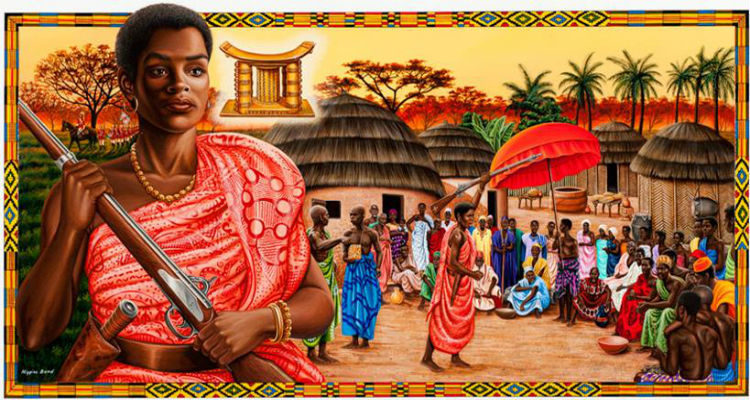The Ashanti Kingdom, one of the most powerful and influential empires in West Africa, has a treasure trove of ancient stories that weave together a rich tapestry of culture, power, and tradition. These stories are more than just folklore; they are the heartbeat of the Ashanti people, offering insight into their values, beliefs, and history.
1. The Birth of the Ashanti Kingdom: A Story of Unity and Strength
The origins of the Ashanti Kingdom are steeped in myth and legend. According to Ashanti tradition, the kingdom was founded in the late 17th century when the Ashanti people were united under the leadership of King Otumfuo Osei Tutu. The famous Golden Stool, which is said to have descended from the heavens, symbolized this unification. It was believed that the stool was a gift from the gods, and whoever possessed it had the divine right to rule.
The Golden Stool Legend
The Golden Stool is not just a throne; it represents the spirit of the Ashanti nation. Legend says that when Osei Tutu was crowned as the first king, the stool appeared from the sky. This sacred object was believed to house the soul of the Ashanti people, making it central to their identity and sovereignty.
2. Anansi the Spider: The Trickster and Wisdom Keeper
One of the most beloved figures in Ashanti folklore is Anansi, the clever spider who is known for his trickster ways and his ability to outwit larger, stronger creatures. Anansi stories have traveled far beyond the Ashanti Kingdom, influencing global folklore.
Anansi’s Wisdom
Anansi is not just a trickster; he is a symbol of resilience and intelligence. He often uses his brains to solve problems where brute strength would fail. Through his stories, the Ashanti people impart important life lessons about cleverness, resourcefulness, and the ability to overcome challenges. These stories are told and retold, teaching both young and old the value of wit over might.
3. The Great Ashanti Warriors: Stories of Bravery and Valor
The Ashanti Kingdom was built on the shoulders of brave warriors, and many tales of their heroic exploits have been passed down through the generations. One such tale is that of Yaa Asantewaa, the legendary queen mother who led the Ashanti army during the War of the Golden Stool in 1900.
Yaa Asantewaa: The Warrior Queen
Yaa Asantewaa’s courage and leadership during the war are celebrated in Ashanti culture. When British colonizers sought to capture the Golden Stool, Yaa Asantewaa rose to defend it. Her bravery inspired not only her people but also future generations of Ashanti warriors.
4. The Ashanti and the Forest Spirits: A Connection to the Divine
Ashanti spirituality is deeply intertwined with nature, and many ancient stories involve the spirits of the forest. The Ashanti believe that the forest is home to powerful deities and spirits that govern various aspects of life. One of the most famous stories involves the Twi-speaking gods, who are believed to dwell in sacred trees and rivers.
The Sacred Forests
The Ashanti’s reverence for the forest is rooted in the belief that these sacred places are the dwelling places of ancestral spirits. According to legend, the first Ashanti ancestors made a pact with the forest spirits, vowing to protect the land in exchange for prosperity and guidance.
5. The Ashanti Kings: Tales of Wisdom, Justice, and Power
The Ashanti Kingdom’s rulers, known as Asantehene (king), were central figures in the governance of the empire. These kings were not only military leaders but also judges and spiritual figures, entrusted with maintaining the balance between the human world and the divine.
King Prempeh I and the British Conquest
One of the most gripping stories in Ashanti history is that of King Prempeh I, who fought valiantly against British colonization in the early 20th century. The Ashanti were a formidable force, and despite losing the war, Prempeh’s refusal to bow to colonial rule is still a source of pride for the Ashanti people today.
6. The Ashanti Symbols: Secrets Embedded in Art and Adinkra
Ashanti symbols, especially Adinkra, are more than just decorative; they carry deep meanings, encapsulating proverbs, beliefs, and historical events. These symbols are used in clothing, pottery, and even architecture.
The Adinkra Symbols and Their Stories
Each Adinkra symbol has a unique story or lesson behind it. For example, the symbol Duafe, which represents beauty and cleanliness, is associated with the mythical figure of a beautiful woman who possessed both external and internal beauty. The symbol Eban stands for security and safety, stemming from the story of a man who built a protective wall to shield his people from danger.
7. The Ashanti and Their Sacred Drums
Drumming is an essential part of Ashanti culture, and many stories are conveyed through the rhythms and beats of the drums. The Atumpan drums, used in royal ceremonies, are known as the “talking drums” because they can mimic the sound of human speech.
The Role of Drums in Ashanti Storytelling
Drums are used to tell stories during festivals and ceremonies, where they provide a musical backdrop to oral narratives. The Ashanti believe that the sound of the drum carries the power to invoke spirits and summon the ancestors, reinforcing the idea that storytelling is a divine act.
Conclusion: The Timeless Legacy of Ashanti Stories
The ancient stories of the Ashanti Kingdom continue to thrive today, passed down through oral traditions and celebrated through festivals and rituals. These stories not only preserve the rich history of the Ashanti people but also serve as guides for how to live, love, and honor the past. As you explore these tales, you’ll find that the Ashanti Kingdom is not just a place—it’s a living, breathing cultural epic.

